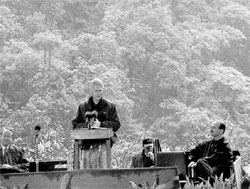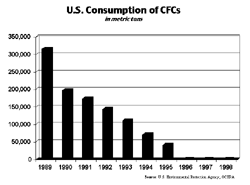|
Protecting the Global Environment
 "We know that more and more the environmental problems of the United States...or any other nation are not just national problems. They are global ones...More than any time in history, the environmental challenges we face go beyond national borders. And so must our solutions. We must work together to protect the environment."
"We know that more and more the environmental problems of the United States...or any other nation are not just national problems. They are global ones...More than any time in history, the environmental challenges we face go beyond national borders. And so must our solutions. We must work together to protect the environment."President Bill Clinton
March 22, 2000
Photo: Braulio Carrillo National Park, Costa Rica,
May 1997
When Americans celebrated the first Earth Day 30 years
ago, our focus was largely our own backyard — our polluted rivers and dirty
skies. Today, we recognize that many environmental challenges know no borders,
and that to meet them, we must work closely with other nations.
Under the leadership of President Clinton and Vice President Gore, the United States has been at the
forefront of international efforts to protect the "global commons" — the oceans, for instance, and
the ozone layer. The Administration also has helped forge international agreements, and worked directly
with individual nations, to reduce the use of toxic chemicals, preserve endangered species, and protect
tropical forests and biodiversity around the globe.
Finally, the President and Vice President have been forceful voices for stronger environmental safeguards
in trade and lending policies, to ensure that the new global economy helps promote, rather than undermine,
environmental protection worldwide.
Healing the Ozone Layer
 Source: U.S. Environmental Protection Agency; OCEPA
Source: U.S. Environmental Protection Agency; OCEPA
One of the most significant threats to the global environment was the widespread
use of chemicals that erode the ozone layer, which protects humans and other
life on Earth from the sun's harsh ultraviolet rays. The Montreal Protocol,
perhaps the most successful international environmental treaty ever, has led
to a dramatic reduction in the production and use of chlorofluorocarbons (CFCs)
and other ozone-depleting chemicals. Although previously released chemicals
will remain in the atmosphere for many years, scientists say recent data show
that the ozone layer is now on its way to recovery.
The Clinton-Gore Administration has worked aggressively to implement and strengthen the Protocol by:
-
Successfully phasing out CFCs by 1996 and other major ozone-depleting substances by 1994, and approving
the introduction of more than 300 safer alternatives.
-
Investing more than $300 million a year in research on atmospheric chemistry and stratospheric ozone
depletion.
-
Leading successful negotiations to reduce Chinese production of halons and CFCs faster than required under
the Protocol; and leading efforts to bring Russia into compliance with the Protocol by securing financial
assistance for the closure of CFC production facilities.
-
Securing an accelerated international schedule for the phase-out of methyl bromide, a leading ozone
depleter.
Promoting Environmentally Responsible Trade
A new global economy is helping to bring prosperity to other nations, and posing new challenges for
ensuring that this new growth is environmentally sound. The President and Vice President have outlined
a strategy to ensure that U.S. efforts to expand trade and promote development reflect a strong commitment
to achieving environmental protection worldwide.
Last year, the President signed an Executive Order requiring careful assessment and written review of the
potential environmental impacts of major trade agreements so that environmental considerations can guide
the development of U.S. positions in trade negotiations. The President also issued a White House Policy
Declaration on Environment and Trade, outlining a set of principles to guide U.S. negotiators and to ensure
that the work of the World Trade Organization is supportive of sustainable development and environmental
protections at home and abroad.
The Administration also has worked to strengthen environmental standards in international lending. It
has instituted stronger standards at U.S. export agencies, and promoted similar efforts at the World
Bank and other international financial institutions, including targets for clean energy lending. The
President recently secured a commitment from other G8 partners for common environmental guidelines for
export credit agencies by 2001.
Targeting Toxic Threats
In the United States, strong, comprehensive measures have significantly reduced the use of toxic chemicals,
ensured safer disposal, and guaranteed the public greater access to information on their use and potential
health risks. The United States has led several international efforts to achieve similar improvements
elsewhere around the world:
Prior Informed Consent. In 1998, the U.S. joined 94 other nations in an international agreement
ensuring developing countries greater access to information on the risks posed by banned and severely
restricted chemicals and pesticides.
Phasing Out Persistent Pollutants. The Administration is leading international negotiations to phase
out 12 of the most dangerous, persistent organic pollutants — such as PCBs, DDT and dioxin — which
threaten health and safety around the world.
Halting Radioactive Waste Dumping. President Clinton led the world in calling for a global ban on
ocean dumping of low-level radioactive waste. The U.S. was the first nuclear power to advocate the ban,
which other nations agreed to in 1993.
Stabilizing Population Growth
At the 1994 International Conference on Population and Development in Cairo, Vice President Gore helped
forge a historic consensus for a global program to stabilize the world's population. The international
strategy calls for increased availability of family planning, the empowerment of women through measures
such as enhanced educational opportunities, and a reduction in infant and child mortality.
Ensuring the Safety of Biotechnology
Biotechnology — the use of genetic engineering to introduce new traits into species — can achieve
tremendous benefits through increased agricultural productivity. Without careful monitoring, however, it
could also pose risks to the environment and biodiversity. U.S. leadership in negotiations earlier this
year helped achieve international agreement on a Biosafety Protocol that will help guard against these risks
without unduly disrupting world food trade.
The Protocol establishes an international framework for addressing the potential environmental impact of
certain bioengineered products. Information and expertise exchanged through this system will help
governments assess the potential risks and benefits of biotechnology in a more predictable and consistent
manner.
Promoting Sustainable Development
Throughout the developing world, nations are struggling to raise their standard of living and provide their
people with a more promising future. Too often, the daily struggle for basic necessities involves
environmentally destructive activities — such as slash-and-burn agriculture — which, in turn,
undermine natural assets that could sustain more productive economies. The Administration is working
through several programs to help developing countries build stronger economies by protecting their natural
endowments.
Currently, the Administration is supporting efforts in 43 countries to improve management of biologically
rich habitats and to address environmental challenges such as forest fires, overfishing, poaching,
deforestation, agricultural encroachment, and mining. Guided by the principle that environmental protection
is linked with democracy and governance, these programs promote transparency and citizen participation in the
management of natural resources.
Protecting Rare and Endangered Species
Many of the world's richest ecosystems are also the most endangered. The Administration is working with many
governments around the world to help protect and restore threatened species by protecting habitat and
combating illegal poaching and trade.
Since 1993, the Administration has provided more than $12 million in grants to more than 30 African and Asian
countries for programs critical to the survival of elephants, rhinos, and tigers, leveraging more than $25
million in matching contributions. These efforts have helped stabilize populations of the African elephant
by stemming illegal ivory poaching. On his recent trip to India, the President announced nearly $250,000 in
grants to non-government organizations for urgent, on-the-ground projects to protect endangered tigers and
elephants. The grants will help conserve habitat, expand research and training, and strengthen
anti-poaching efforts.
Galapagos Islands
Preserving a World-Class Treasure
| 
